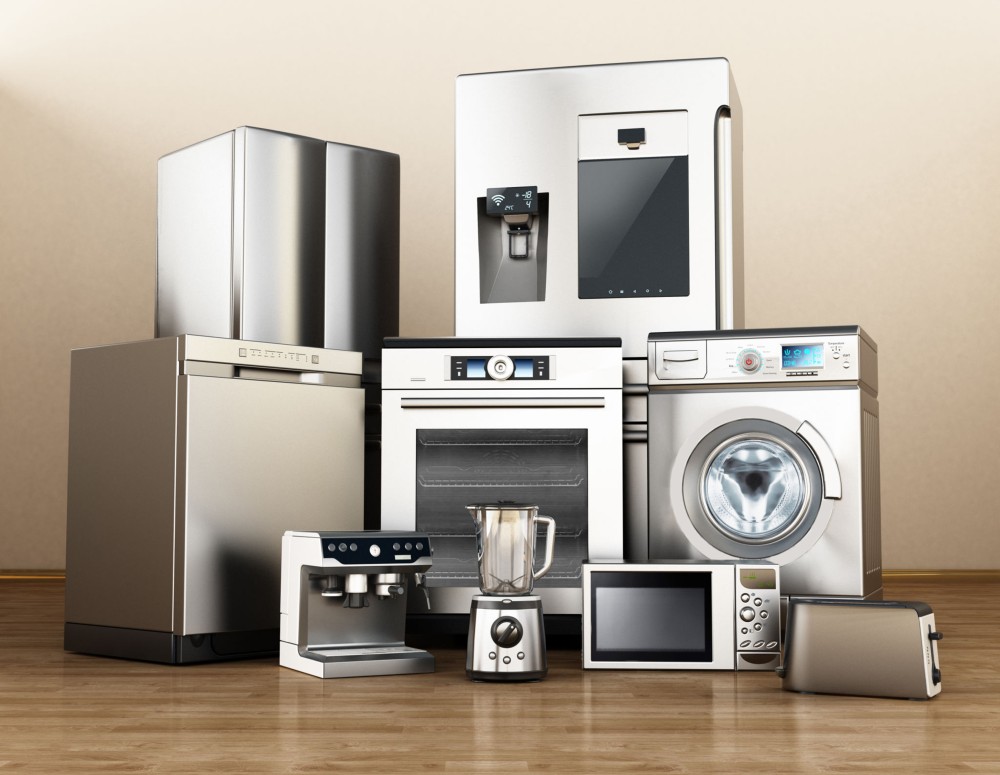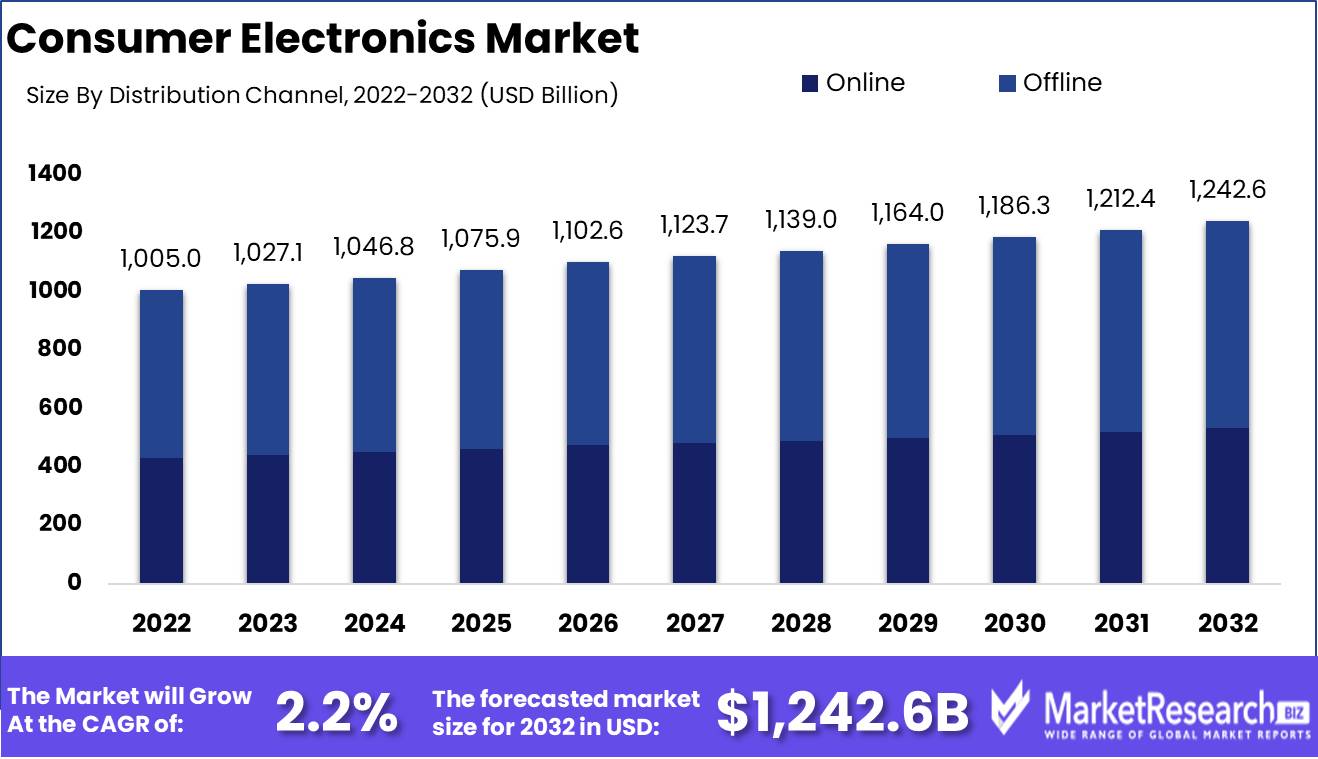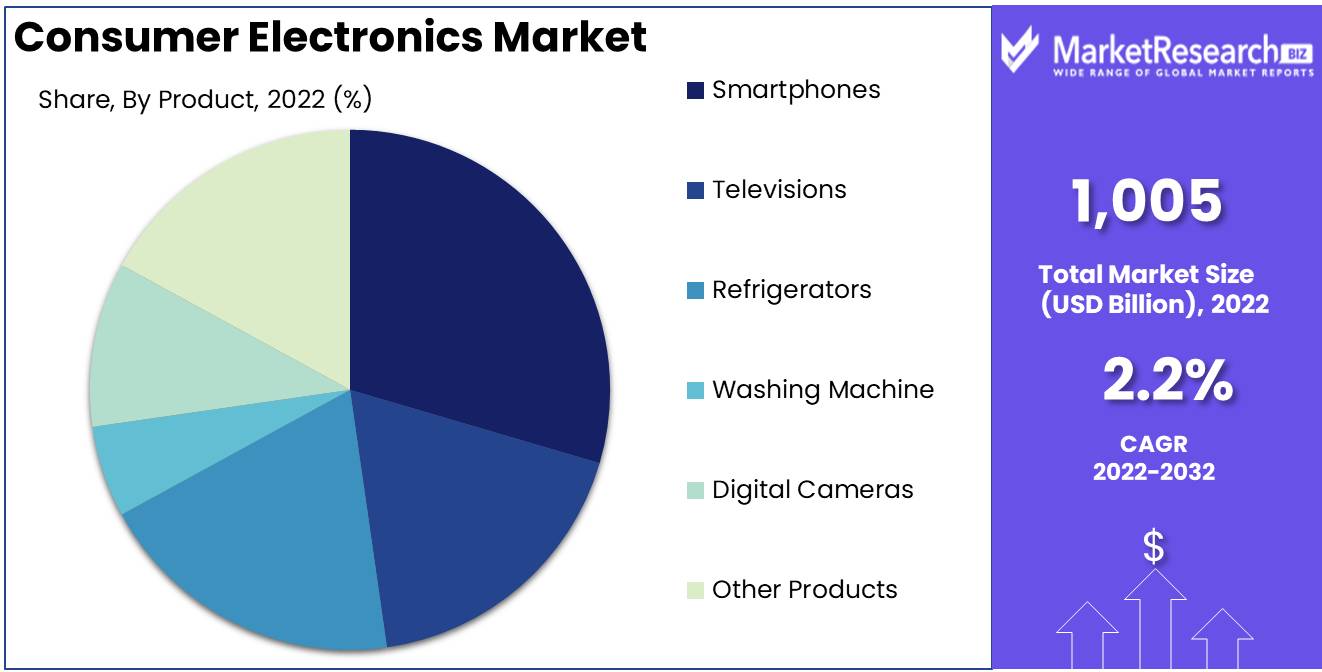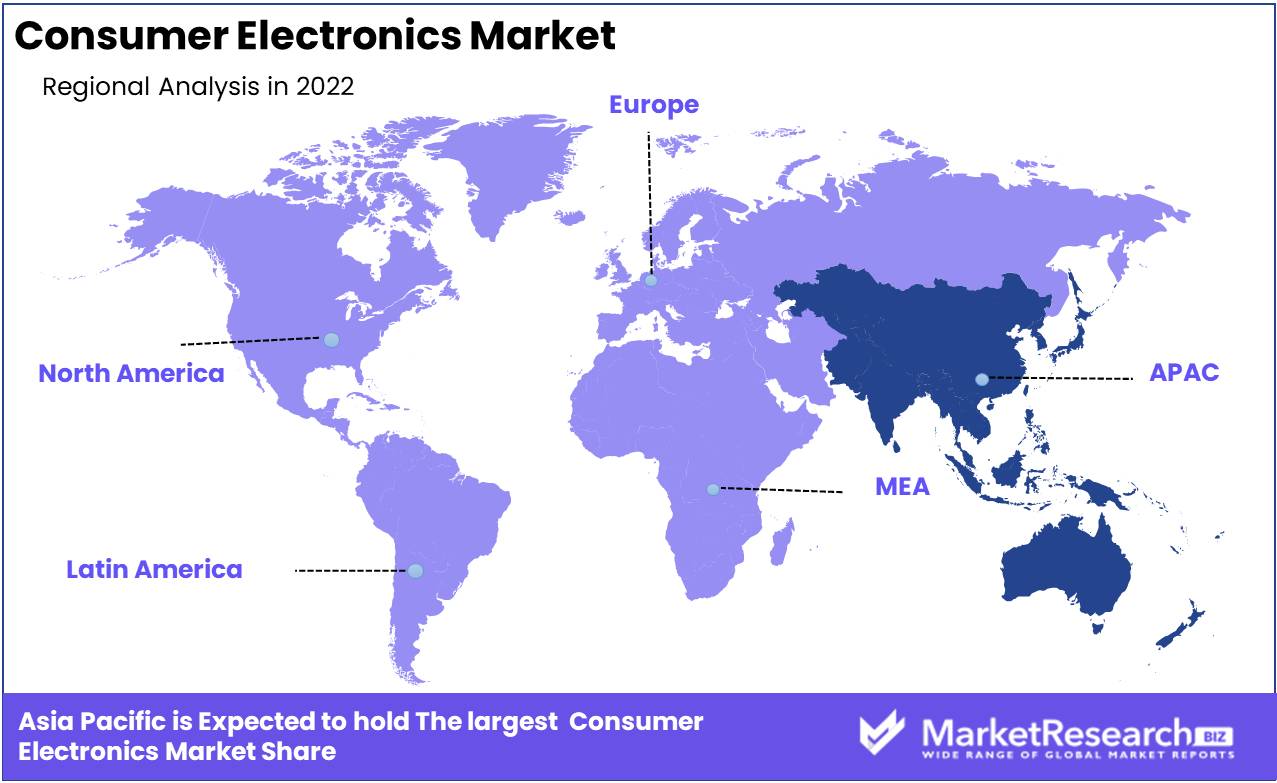
Consumer Electronics Market By Product(Smartphones, Televisions, Other), By Distribution Channel(Online, Offline), By Region And Companies - Industry Segment Outlook, Market Assessment, Competition Scenario, Trends, And Forecast 2023-2032
-
3079
-
Jul 2023
-
165
-
-
This report was compiled by Research Team Research team of over 50 passionate professionals leverages advanced research methodologies and analytical expertise to deliver insightful, data-driven market intelligence that empowers businesses across diverse industries to make strategic, well-informed Correspondence Research Team Linkedin | Detailed Market research Methodology Our methodology involves a mix of primary research, including interviews with leading mental health experts, and secondary research from reputable medical journals and databases. View Detailed Methodology Page
-
Quick Navigation
Report Overview
Consumer Electronics Market size is expected to be worth around USD 1,242.6 Bn by 2032 from USD 1,005 Bn in 2022, growing at a CAGR of 2.2% during the forecast period from 2023 to 2032.
The consumer electronics market is the sector comprising electronic devices and gadgets designed for common consumer use. These devices are intended to improve convenience, entertainment, communication, and quality of life in general. The objectives of the consumer electronics market are to continuously innovate and deliver products that meet the evolving requirements and desires of consumers, offering them cutting-edge technology and enhancing their daily experiences.

The consumer electronics market's significance cannot be exaggerated. With the development of technology, consumer electronics have become an integral part of our daily existence. From smartphones to smart appliances, these devices have transformed how we communicate, work, and have fun. The numerous benefits of consumer electronics range from increased productivity and efficiency to enhanced connectivity and entertainment options.
Internet of Things (IoT) is a notable innovation in the consumer electronics market. This concept entails connecting diverse devices and appliances to the internet, allowing them to communicate with one another and providing users with a seamless and interconnected experience. The Internet of Things has paved the way for the development of smart residences, in which appliances, lighting, security systems, and even air conditioning can be controlled by smartphone or voice command.
Tech titans including Apple, Samsung, Google, and Amazon have made significant investments in the consumer electronics market. These businesses invest heavily in research and development to remain ahead of the competition and continually strive to introduce ground-breaking innovations to the market. In addition, traditional industries such as healthcare, automotive, and home automation are integrating consumer electronics into their products and services, resulting in a convergence of industries.
Driving factors
Boosting Consumer Discretionary Income
The quantity of money that can be spent on a single item is known as the "crowd" tax. This increased purchasing power has fuelled the demand for consumer electronics, allowing individuals to acquire the most up-to-date devices and technologies. As a result, companies catering to the consumer electronics market have witnessed a surge in sales, resulting in increased profits and business growth. The ability to drive a car is a fantastic way to earn money, but it's also a great way to lose weight.
Digital Lifestyle and Entertainment Industry Expansion
In recent years, the digital lifestyle and entertainment industries have flourished, with consumers relying more and more on technology to enhance their entertainment experiences. The introduction of streaming platforms, the rise of online gaming, and the expansion of social media have shaped a digital era in which people seek immersive and engaging entertainment options. In order to keep up with this growing trend, consumers demand cutting-edge electronic devices with seamless connectivity, crystal-clear displays, and immersive audiovisual experiences. As a consequence, the market for consumer electronics has grown significantly, with many companies now offering their products online.
Technological Progress and Product Innovation
Innovations in technology and products play a crucial role in driving the growth of the consumer electronics market. From smartphones with enhanced camera capabilities to virtual reality devices that transport users to an alternate universe, technological advancements have transformed the consumer electronics industry. As companies compete to remain one step ahead of their rivals, they invest heavily in R&D to introduce innovative products to the market. The growth of the consumer electronics market is further fueled by these advancements, which not only attract tech-savvy consumers but also pique the interest of a broader consumer base.
Demand for connected and portable devices is growing.
The increasing prevalence of connected devices and the demand for portability have revolutionized the consumer electronics market. Today's consumers pursue devices that seamlessly synchronize and communicate with one another, forming a network of interconnected devices. The demand for connected devices has skyrocketed, as smartphones connect to smartwatches and TVs synchronize with voice-controlled devices. Moreover, the lifestyle of contemporary consumers necessitates portability, enabling them to carry their devices with them wherever they go. This increasing demand for connected and portable devices has stimulated substantial growth in the consumer electronics market.
Restraining Factors
Possible Saturation of the Market and Lengthening Replacement Periods
The market for consumer electronics is extremely dynamic, characterized by a constant flood of new product introductions that captivate consumers. This rate of innovation and influx of new products can contribute to market saturation, however. As more competitors enter the market, it becomes more challenging for businesses to carve out their own niche and capture the attention of consumers. To avoid becoming confused in a sea of competitors, it is essential to efficiently target the appropriate market segments. A further factor contributing to market saturation is the lengthening replacement cycles for consumer electronics. Due to diminishing technological advancements between product iterations, consumers are frequently more inclined to retain their current devices for longer periods of time.
Considerable Pricing and Affordability Factors
Frequently, the price of a smartphone, tablet, or laptop exceeds the cost of the device itself. This factor can hinder market penetration and limit the availability of these products to a larger demographic. In emerging markets and among price-conscious consumers, where the desire for innovative devices conflicts with limited purchasing power, affordability issues arise. To counteract this constraining factor, businesses must explore various pricing strategies, such as providing budget-friendly alternatives or introducing payment plans, to make their products more affordable and appealing to a larger number of customers. Conversation is the best method to spread the word about your company's new product.
Product Analysis
The consumer electronics market has experienced a significant uptick in recent years, with the majority of the market's growth occurring in the United States. Numerous factors have contributed to the pervasive adoption and incorporation of these technologies into our daily lives, which has resulted in this increase in popularity.
One of the primary reasons for the success of smartphones is the constant technological advancements they offer. Manufacturers introduce cutting-edge features with each new model, such as high-speed internet access, seamless social media integration, advanced camera capabilities, and access to a vast array of applications. Smartphones are now an indispensable instrument for communication, entertainment, and productivity thanks to these features.
In addition, the growth of smartphones is not restricted to developed nations. Emerging economies have also experienced substantial economic growth, resulting in increased internet penetration and disposable incomes. As a consequence, consumers in these regions rely on smartphones for communication and entertainment. Smartphone manufacturers have designed budget-friendly devices to meet the needs of consumers in these economies, thereby accelerating the growth of this market segment.

Distribution Channel Analysis
The offline segment has dominated the distribution of consumer electronics. This segment includes brick-and-mortar retail stores, electronics shops, department stores, and specialty stores that sell consumer electronics directly to end users.
Personalization is one of the primary factors contributing to the offline segment's dominance. The ability for consumers to physically interact with the products, ask questions, and seek assistance from sales representatives can significantly influence their purchasing decisions. This personalized experience enhances consumers' trust and confidence in the product, particularly those who prefer to see and touch the device prior to purchase.
In addition, many consumers still prefer the traditional shopping experience offered by physical stores because it enables them to compare various brands and models in person, resulting in a more informed purchase decision. This is especially true for high-priced items such as smartphones, laptops, and televisions, where consumers want to be certain they are making the best decision.
Key Market Segments
By Product
- Smartphones
- Televisions
- Refrigerators
- Washing Machine
- Digital Cameras
- Other Products
By Distribution Channel
- Online
- Offline
Growth Opportunity
Integration of Augmented Reality (AR) and Virtual Reality (VR)
As the consumer electronics market embraces innovation, the incorporation of augmented reality (AR) and virtual reality (VR) technologies into electronic products can create new expansion opportunities. AR and VR offer immersive experiences in various industries, including entertainment, gaming, education, healthcare, and more, by fusing the digital and physical realms. The projected increase in demand for AR and VR-enabled devices and content presents an opportunity for consumer electronics companies to capitalize on this trend. Utilizing this technology can boost competitiveness, attract new customers, and stimulate revenue growth in the consumer electronics market.
Connectivity of Internet of Things (IoT) Devices
The Internet of Things (IoT) has ushered in a plethora of opportunities for the consumer electronics industry. By connecting electronic devices and home appliances to a network, IoT enables seamless communication and coordination, thereby enhancing user experiences and enhancing convenience. The integration of IoT technology into consumer electronics has the potential to enable, among other things, smart homes, connected health and wellness devices, and energy-efficient solutions. Consumer electronics manufacturers can access a rapidly expanding market and obtain a competitive edge by capitalizing on IoT connectivity.
Increased Data Security and Privacy Protections
With the proliferation of consumer electronic devices that collect and store personal data, it is essential to implement stringent data security and privacy measures. Consumers are growing increasingly concerned about the security of their personal data. Innovation and investment in cutting-edge security solutions, such as biometric authentication, encryption methods, and secure cloud storage, can inspire consumer confidence and trust. By prioritizing data security and privacy, consumer electronics companies can distinguish themselves from market competitors, attracting a larger client base and fostering long-term relationships.
Latest Trends
Growth of Smartphones and Tablets
Smartphones and tablets have become indispensable in our lives, connecting us to the digital world in unprecedented ways. These devices have revolutionized communication, entertainment, and productivity with their advanced capabilities. From web browsing to media streaming, and social networking to mobile entertainment, smartphones and tablets have given consumers limitless options. As the market continues to expand, manufacturers are introducing cutting-edge technologies such as foldable displays, 5G connectivity, and augmented reality to expand the capabilities of these devices.
Demand for Smart Home Entertainment Systems
In recent years, the concept of a smart home, in which various devices and appliances are interconnected and can be remotely controlled, has garnered significant traction. With the advent of voice assistants such as Amazon Alexa and Google Assistant, consumers can now control their entertainment systems, lighting, and thermostats with simple vocal commands. This integration has created a seamless user experience by transforming our living spaces into more convenient and efficient environments. As consumers seek to enhance home entertainment and automate mundane tasks, the demand for smart TVs, smart speakers, streaming devices, and other smart home entertainment systems has skyrocketed.
Utilization of Bluetooth- and wireless-capable devices
As more and more consumer electronics embrace wireless technologies, the era of tangled wires and cables is progressively fading away. Particularly, Bluetooth-enabled devices have become widespread, enabling seamless connectivity between smartphones, tablets, headphones, speakers, and other accessories. This wireless revolution has liberated consumers, allowing them to listen to music, make hands-free communications, and easily control their devices. Wireless audio, wireless charging, and wireless data transfer have all experienced an industry-wide transition as a result of the freedom and convenience provided by wireless technologies, which has increased demand for products with this connectivity.
Regional Analysis
Asia-Pacific Region Dominates the Consumer Electronics Market
The Asia-Pacific region, which includes China, Japan, South Korea, India, and Australia, is home to approximately 4.5 billion individuals. This massive consumer base offers consumer electronics manufacturers a vast market primed for exploration. Consumers in this region are known for their tech-savvy and eagerness to adopt the latest innovations. From smartphones to smart household devices, Asian consumers are constantly in search of cutting-edge devices that improve their lifestyles.
China, one of the leading participants in the Asia-Pacific consumer electronics market, stands out for its size and economic strength. As the world's most populous nation, China offers global tech titans a vast market. In recent years, Chinese manufacturers have also risen to prominence, posing a threat to industry leaders with their competitive pricing and innovative products. This combination has considerably contributed to the region's dominance within the consumer electronics industry.
The e-commerce revolution is a significant factor contributing to Asia-Pacific's dominance. Electronics shopping has been revolutionized by online marketplaces such as Alibaba and Amazon in China and India. The growth of online retail has been fuelled by the accessibility and variety of products offered on these platforms. With the press of a button, consumers in remote villages or bustling metropolises can order the newest electronic devices and have them delivered to their doorstep. This accessibility has boosted the region's market for consumer electronics.
The increasing middle class in the Asia-Pacific region has also been instrumental in the region's consumer electronics market's dominance. As incomes and living standards rise, more people have disposable income to spend on luxury items, such as electronics. The desire to display their social status and keep up with the latest trends has fueled the demand for high-end electronics. The Asia-Pacific region is a hotspot for premium consumer electronics, including smartphones with advanced cameras and elegant laptops with potent processors.

Key Regions and Countries
North America
- US
- Canada
- Mexico
Western Europe
- Germany
- France
- The UK
- Spain
- Italy
- Portugal
- Ireland
- Austria
- Switzerland
- Benelux
- Nordic
- Rest of Western Europe
Eastern Europe
- Russia
- Poland
- The Czech Republic
- Greece
- Rest of Eastern Europe
APAC
- China
- Japan
- South Korea
- India
- Australia & New Zealand
- Indonesia
- Malaysia
- Philippines
- Singapore
- Thailand
- Vietnam
- Rest of APAC
Latin America
- Brazil
- Colombia
- Chile
- Argentina
- Costa Rica
- Rest of Latin America
Middle East & Africa
- Algeria
- Egypt
- Israel
- Kuwait
- Nigeria
- Saudi Arabia
- South Africa
- Turkey
- United Arab Emirates
- Rest of MEA
Samsung, a South Korean conglomerate, is a dominant force in the consumer electronics market. With a strong focus on innovation and cutting-edge technology, Samsung has emerged as a global leader in various sectors, including smartphones, televisions, home appliances, and more. The company has been at the forefront of developing stunning displays, including QLED and OLED technologies. These advancements have revolutionized the viewing experience, offering deeper blacks, vibrant colors, and exceptional picture quality.
LG Electronics, another South Korean giant, is renowned for its diverse range of consumer electronic products. The company's commitment to innovation is evident in its cutting-edge technology, superb designs, and exceptional functionality. LG has emerged as a key player in the television industry with its OLED displays. OLED technology offers superior image quality, increased contrast, and incredibly thin screens. With its range of OLED televisions, LG has gained a strong foothold in the market by providing viewers with an unparalleled visual experience.
Sony Corporation, a Japanese multinational conglomerate, has been a prominent player in the consumer electronics market for decades. Known for its commitment to quality and innovation, Sony continues to deliver top-notch products that exceed consumer expectations.
Sony has been a frontrunner in the digital imaging industry, continually pushing the boundaries of camera technology. From its professional-grade Alpha series cameras to its compact Cyber-shot models, Sony offers a diverse range of options for both photography enthusiasts and professionals alike. With their advanced sensors and innovative features, Sony cameras have become a preferred choice for capturing stunning visuals.
Top Key Players in Consumer Electronics Market
- Samsung (South Korea)
- LG Electronics (South Korea)
- Sony Corporation (Japan)
- Panasonic Corporation (Japan)
- Koninklijke Philips N.V. (Netherlands)
- Whirlpool Corporation (U.S.)
- Electroluxgroup (Sweden)
- Apple Inc. (U.S.)
- HP Development Company
- L.P. (U.S.)
- Huawei Technologies Co. Ltd. (China)
- Teledyne (U.S.)
- Allied Vision Technologies GmbH (Germany)
- Texas Instruments Incorporated (U.S.)
- Intel Corporation (U.S.)
- Baumer (Germany)
- JAI (Denmark)
- MediaTek Inc. (Taiwan)
Recent Development
- In 2023, Apple's announcement that it will launch a new line of consumer electronics in 2021 was a game-changer. Though specific details are still shrouded in secrecy, industry insiders predict that Apple's new offerings will set new standards for performance, design, and functionality.
- In 2022, Samsung made ripples by announcing that it would expand its already diverse portfolio with new products and services in an effort to maintain its dominant position in the consumer electronics market. The world's most well-known company, Samsung, is known for its innovative products and services.
- In 2021, Sony, renowned for its commitment to delivering cutting-edge devices, delighted consumers with the announcement of a new line of consumer electronics products to be released. In order to meet the demands of today's consumers, the company must first establish a solid foundation of knowledge and experience.
Report Scope:
Report Features Description Market Value (2022) USD 1,005 Bn Forecast Revenue (2032) USD 1,242.6 Bn CAGR (2023-2032) 2.2% Base Year for Estimation 2022 Historic Period 2016-2022 Forecast Period 2023-2032 Report Coverage Revenue Forecast, Market Dynamics, COVID-19 Impact, Competitive Landscape, Recent Developments Segments Covered By Product(Smartphones, Televisions, Other), By Distribution Channel(Online, Offline) Regional Analysis North America – The US, Canada, & Mexico; Western Europe – Germany, France, The UK, Spain, Italy, Portugal, Ireland, Austria, Switzerland, Benelux, Nordic, & Rest of Western Europe; Eastern Europe – Russia, Poland, The Czech Republic, Greece, & Rest of Eastern Europe; APAC – China, Japan, South Korea, India, Australia & New Zealand, Indonesia, Malaysia, Philippines, Singapore, Thailand, Vietnam, & Rest of APAC; Latin America – Brazil, Colombia, Chile, Argentina, Costa Rica, & Rest of Latin America; Middle East & Africa – Algeria, Egypt, Israel, Kuwait, Nigeria, Saudi Arabia, South Africa, Turkey, United Arab Emirates, & Rest of MEA Competitive Landscape Samsung (South Korea), LG Electronics (South Korea), Sony Corporation (Japan), Panasonic Corporation (Japan), Koninklijke Philips N.V. (Netherlands), Whirlpool Corporation (U.S.), Electroluxgroup (Sweden), Apple Inc. (U.S.), HP Development Company, L.P. (U.S.), Huawei Technologies Co. Ltd. (China), Teledyne (U.S.), Allied Vision Technologies GmbH (Germany), Texas Instruments Incorporated (U.S.), Intel Corporation (U.S.), Baumer (Germany), JAI (Denmark), MediaTek Inc. (Taiwan) Customization Scope Customization for segments, region/country-level will be provided. Moreover, additional customization can be done based on the requirements. Purchase Options We have three licenses to opt for: Single User License, Multi-User License (Up to 5 Users), Corporate Use License (Unlimited User and Printable PDF) -
-
- Samsung (South Korea)
- LG Electronics (South Korea)
- Sony Corporation (Japan)
- Panasonic Corporation (Japan)
- Koninklijke Philips N.V. (Netherlands)
- Whirlpool Corporation (U.S.)
- Electroluxgroup (Sweden)
- Apple Inc. (U.S.)
- HP Development Company
- L.P. (U.S.)
- Huawei Technologies Co. Ltd. (China)
- Teledyne (U.S.)
- Allied Vision Technologies GmbH (Germany)
- Texas Instruments Incorporated (U.S.)
- Intel Corporation (U.S.)
- Baumer (Germany)
- JAI (Denmark)
- MediaTek Inc. (Taiwan)




